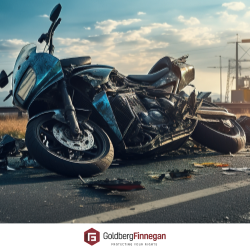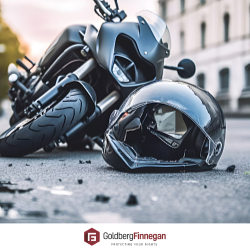Motorcycle Accident Lawyers in Silver Spring, MD Fighting for the Rights of Accident Victims
Make your Maryland motorcycle accident claim count – contact our law firm
Motorcycle accidents happen fast in Silver Spring and throughout Maryland. Our Silver Spring motorcycle accident attorneys know due to our years of experience handling such complex cases. In an instant, you or a loved one can sustain a concussion or another type of injury in a motorcycle crash on I-495 or Silver Spring’s East-West Highway. Sometimes, speeding drivers on 16th Street are to blame. Or perhaps a distracted driver on Georgia Avenue is at fault.
 If you have been injured in a motorcycle accident it is important to understand what protections under the law you have. The long-term and short-term effects of a motorcycle injury can be life changing. You may suffer from serious injuries that prevent you from returning to work for a lengthy amount of time. You may experience severe emotional trauma, as well as find yourself in extreme financial distress due to your prolonged inability to work.
If you have been injured in a motorcycle accident it is important to understand what protections under the law you have. The long-term and short-term effects of a motorcycle injury can be life changing. You may suffer from serious injuries that prevent you from returning to work for a lengthy amount of time. You may experience severe emotional trauma, as well as find yourself in extreme financial distress due to your prolonged inability to work.
If you have been injured, you may be able to seek compensation for your pain and suffering. In these cases, pursuing compensation through a motorcycle accident claim is often the best way to ensure that the responsible party helps bear financial accountability for your pain and suffering. Contact a qualified, Maryland motorcycle accident attorney at Goldberg Finnegan as soon as possible and scheduling a free consultation today.
Maryland motorcycle accidents by the numbers
- Every 9 hours and 22 minutes – motorcycle injury occurs in Maryland.
- 72 motorcycle accident fatalities each year on average in state.
- 1 percent of all Maryland motor vehicle accidents involve motorcycles.
- 3 percent of injury-related accidents statewide involve motorcyclists.
- 14 percent of fatal motor vehicle accidents statewide involve motorcyclists.
Source: Maryland Department of Transportation
What are the common causes of motorcycle accidents?
A motorcycle accident can be the result of a number of factors including, but not limited to a driver speeding, tailgating, driving under the influence of drugs or alcohol, and cutting off a motorcyclist at an intersection. However, one of the most common causes of these types of accidents is a left-hand turn that is made in front of a motorcyclist who has the right of way.
If you have suffered injuries in a motorcycle accident, you should consider seeking legal help to get the justice you deserve. While no amount of money will ever be able to reinstate the life you enjoyed prior to your accident, compensation might assist you in paying for costs not covered by your insurance along with expensive medical bills that you may experience as a result of your injuries.
How much is my motorcycle accident worth?
There’s no set dollar amount when comes to motorcycle crashes. How much money your motorcycle injury claim or lawsuit is worth can vary depending on a wide range of factors, including:
- Total cost of your medical care, including future, anticipated medical treatments and follow-up surgery.
- Motorcycle repairs or the cost of buying a new motorcycle if it’s a total loss due to the crash.
- Replacement income if you need time off from work to recover from your motorcycle accident injury.
- Lost future income if you cannot return to work due to a permanent disability sustained in your motorcycle crash.
So, what’s the best way to know for sure how much money your motorcycle crash is worth? Talk to an experienced Maryland motorcycle accident lawyer from our law firm.
How can I recover compensation in a motorcycle accident case?
Under the law, if you are injured in a car accident due to driver negligence you may be entitled to financial compensation. Normally, compensation is awarded based on both economic losses as well as non-economic losses.
- Economic Losses: This type of loss includes both past and future hospital bills along with medical expenses, rehabilitation services, loss of income, and loss of earning capacity for future wages.
- Non-economic Losses: This includes pain and suffering (past and future), emotional distress (past and future), physical impairment (past and future), and loss of enjoyment of life.
You need an experienced motorcycle accident attorney to help you determine the amount of financial compensation you may be able to recover based on the facts of your case and the ability to prove the extent of your injuries. We can help direct you through this difficult process to make the most out of your personal injury claim.
Who’s responsible for paying for my motorcycle accident?
 Like many states, Maryland has an at-fault car insurance system. This means the at-fault party is responsible for paying injury victims for all their accident-related expenses, which can quickly add up to a lot of money.
Like many states, Maryland has an at-fault car insurance system. This means the at-fault party is responsible for paying injury victims for all their accident-related expenses, which can quickly add up to a lot of money.
So, who’s responsible for paying for your accident expenses if someone else caused your motorcycle crash? Sometimes, it is the actual driver who must pay your bills. But often, it’s the at-fault driver’s insurance company that is liable, a legal term for who’s legally responsible for paying for your accident.
But don’t simply assume that’s the case. Many times, accident claims can be complicated. This is especially true in cases involving motorcycle crashes. Even if you know the other driver caused your crash, don’t be surprised if the at-fault driver’s insurance company refuses to pay for your crash.
Why should I hire a Maryland motorcycle accident attorney?
Many motorcycle accident victims do not realize the scope of their legal options when they have sustained a serious injury. The at-fault driver’s insurance company will often try to reach a settlement for substantially less money than your claim is worth.
The fact is that you may be entitled to fair compensation for injuries such as pain and suffering you have sustained following a motorcycle accident.
If you have sustained a serious injury in a motorcycle crash, the first step towards getting justice is hiring a Goldberg Finnegan motorcycle accident attorney with experience handling motorcycle accident cases comparable to yours. If you want the best chance of receiving maximum compensation for medical bills, lost wages, and more, contact Goldberg Finnegan immediately and schedule a free consultation. We can guide you through this complex process.
Should I hire a motorcycle accident lawyer in Silver Spring, MD?
The lawyers at Goldberg Finnegan have been protecting the rights of those involved in motorcycle accident cases in Silver Spring for years. We understand that no amount of money will be able to bring back the life and health you enjoyed prior to your injuries.
However, we also know that our clients deserve a just settlement for their lost wages, medical bills, pain and suffering, and other liabilities caused by another driver. If you have sustained injuries in a motorcycle accident, contact Goldberg Finnegan as soon as possible and schedule a free consultation today. Our Silver Spring motorcycle accident attorneys are here to help you every step of the way.
